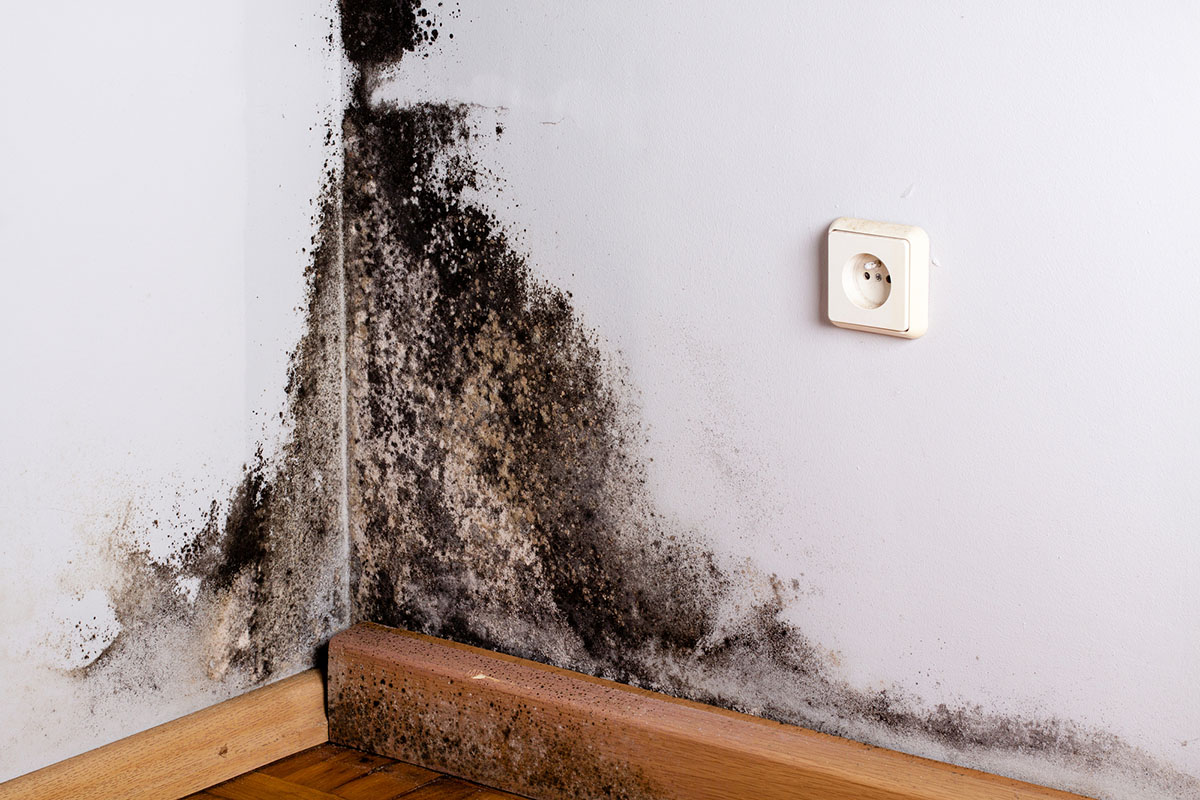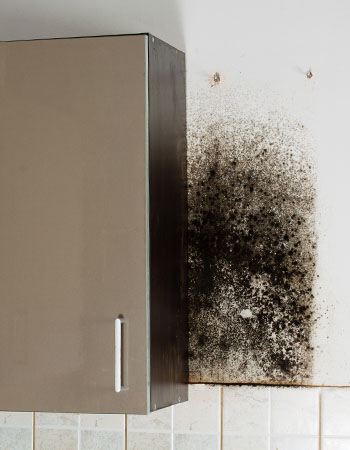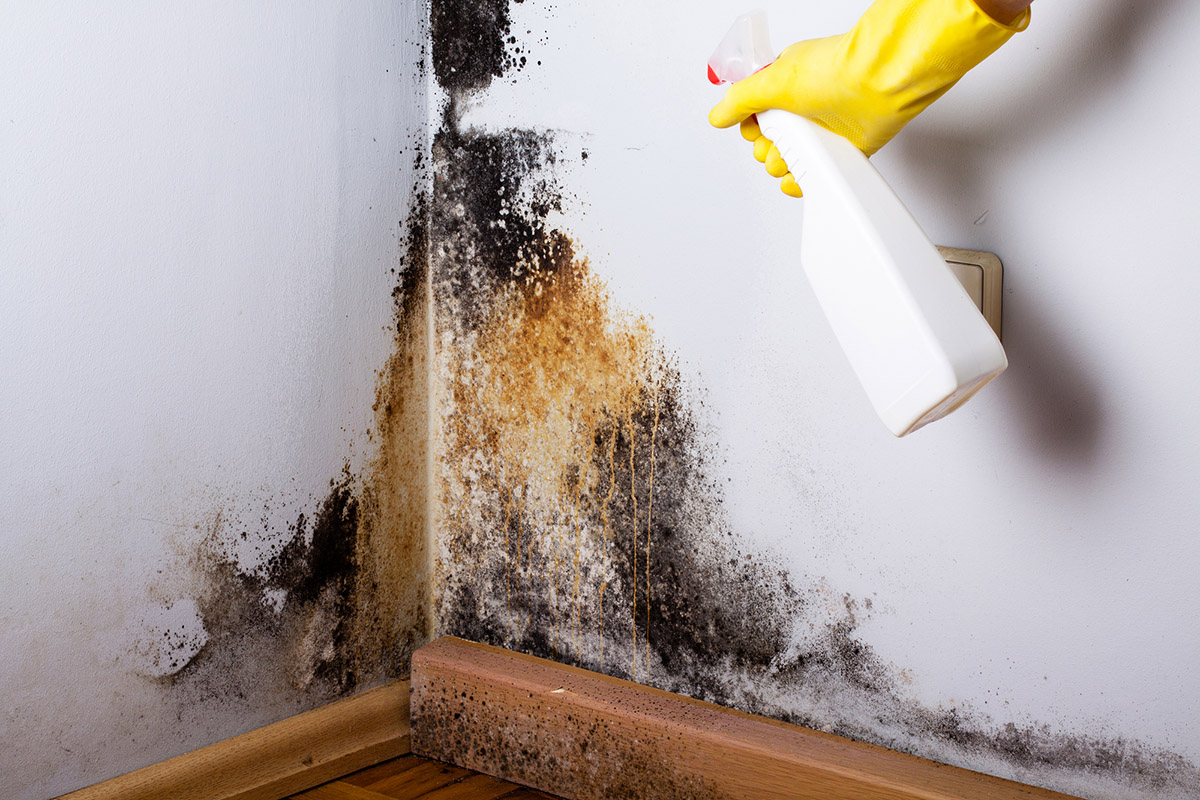

We may earn revenue from the products available on this page and participate in affiliate programs. Learn More ›
Q. There are some odd black stains that suddenly appeared on a wall in my basement. Should I be worried that it’s mold? What does black mold look like?
A: No homeowner wants to discover black mold. Not only is it unpleasant to look at and smell, but certain varieties of black mold can also be a health hazard. Generally, black mold is indeed black in color, but it can also present itself differently depending on the stage of its growth.
If you suspect mold is growing in your home, you may be wondering: What does black mold look like, and how can I get rid of it? To help, here’s what you should know about black mold, including what it looks like and where it commonly grows.
It is a black stain that covers an area that has been flooded or damaged by water.

Black mold typically presents as a black stain covering a high-moisture area, most often one that has been flooded or damaged by water. It is most commonly found in bathrooms with frequently used tubs and showers, as this is an area that is most likely to suffer from flooding, water damage, or inadequate ventilation systems.
However, it can also affect any area with damp conditions, poor ventilation, and high temperatures; damp basements, kitchens, and laundry rooms can all serve as a breeding ground for black mold. Even stagnant leaks and floods can contribute to mold growth.
Black mold usually appears on wooden surfaces that have a water source nearby.
Black mold can also grow on wooden surfaces if there is a nearby water source. Common areas include wood trims on bathroom walls, cabinets underneath kitchen or bathroom sinks, and wooden furniture found in damp basements.
Because wood is highly porous, the mold is able to grow on the surface while also growing roots deep within. Black mold growth on wooden surfaces can be particularly difficult to remove.
Black mold usually spreads in the form of patches or small circles, but it can have irregular patterns as well.
Black mold typically grows in a circular pattern, with round colonies ranging from less than an inch to many inches across. It may also spread in the form of a concentric circle pattern. However, it is also common to see dark or black irregular patches of mold, ranging from a few inches to several inches across.
Most black mold shapes and patterns will appear slimy or shiny due to the moisture of the environment in which it grows. However, if leaks have been fixed, the mold will appear to be dry and even powdery.
Black mold is usually present in drywall, under carpets, or in corners of walls that have been flooded.
In addition to damp rooms and moisture-exposed wood, mold can grow in some less obvious (and less visible) spaces as well. Water leaks from a home’s pipes, bathroom, HVAC units, or roofs, as well as improper ventilation, can all contribute to black mold growth in and on various surfaces.
Porous surfaces, such as drywall and carpets, are particularly susceptible to black mold growth following moisture exposure. Water can also accumulate near the corners of walls after a flood or leak, causing the mold to grow within these nooks and crannies.
Black mold can be a gray or green color.
Like most molds, black mold starts to grow as fuzzy white fibers, looking similar to a cotton ball. However, this is not commonly seen outside of the laboratory environment, as this small, light mold is often well-hidden in a home environment.
As black mold develops and begins to produce spores, it may look gray or green in the center with white around the edges. As the spores fill in and the mold reaches maturity, it develops its characteristic black hue. While black mold in the home is typically found at full maturity, keep an eye on any gray or green mold as well, as it could be black mold in its earlier stages.

What Should I Do if I Find Black Mold?
If a homeowner finds black mold in their home, the next steps will depend on how significant the spread is.
If black mold has moved into the walls, it is recommended to hire a mold-removal specialist to stop it from spreading further. Additionally, individuals with a medical condition or who are particularly sensitive to mold are advised not to handle a mold problem themselves.
However, if the mold is confined to an accessible hard surface, such as a wood trim or basement floor, healthy homeowners may be able to tackle the removal by themselves.
For those who want to try a DIY approach before calling in a local professional, here’s a step-by-step guide on how to remove black mold:
- Locate the source of the mold. Follow the source of the musty smell, and inspect any nooks and crannies or dark spaces with a flashlight.
- Get a spray bottle and create a mold-fighting solution. Tea tree oil and grapefruit seed extract are among the most effective disinfecting and deodorizing agents, and they are also completely nontoxic. For every 1 cup of water the spray bottle holds, add a teaspoon of either the tea tree oil or grapefruit seed extract.
- Put on the appropriate protective gear. This includes disposable coveralls, rubber gloves, airtight safety goggles, and a face mask or respirator. Black mold exposure can lead to a host of problems, including respiratory infections, allergic reactions, and even blindness. Wearing protective gear can significantly reduce the risk of exposure and associated health issues.
- Apply the cleaning solution. Shake the spray bottle of mold-fighting solution, spray the area until it’s well-saturated, and let the liquid sit for 5 to 10 minutes. Do not scrape dry mold, as this can allow the toxic spores to spread into the air.
- Scrub the surface area thoroughly with a nylon bristle brush to lift and unsettle the dampened mold. Then, wipe the area clean with rags or paper towels. Repeat as necessary until the mold is removed, and dispose of any materials used in a sealed plastic bag.
If the mold returns or if you are unsure of your ability to complete this task on your own, play it safe and hire a professional. While the Centers for Disease Control (CDC) says that it is unnecessary to identify the type of mold present before treating it, the information may help homeowners in case mold returns.
A working knowledge of common home problems can be a powerful tool in a homeowner’s arsenal. Being aware of what black mold is and how to remove it can empower homeowners to resolve this potentially hazardous issue.
